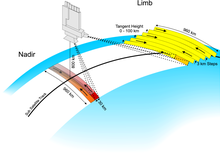Netherlands Institute for Space Research

The SRON Netherlands Institute for Space Research is a Dutch agency under the Dutch Organisation for Scientific Research (NWO) responsible for promoting, coordinating and supporting Dutch activities in space research. SRON develops satellite instruments for astrophysics and earth sciences[1].
SRON was founded in 1983 under the former names Stichting Ruimteonderzoek Nederland / Space Research Organisation Netherlands. Its stakeholders include major space agencies such as ESA and NASA. The institute is managed by a Governing Board, consisting of members from the scientific community, that oversees the daily running of the agency. The governing board is advised by a Science advisory council on long term plans to maintain a consistent strategy for the agency.[2]
The institute has two facilities in The Netherlands. The main one located in the eastern part of Utrecht, and the second one located in the northern part of Groningen.
Departments
The agency is divided into three separate sections, with each section specializing in a research area. Apart from the three main sections, SRON maintains two other departments, the Engineering division and the Sensor Research and Technology division.
High Energy Astrophysics
The High Energy Astrophysics (HEA) division is located at Utrecht since 1994, when it merged with another research group from Leiden. The group specialises in the manufacturing and integration of X-ray and Gamma instruments, typically integrated and flown on other space agencies satellites. Notable instrumentation contributions include the Wide-Field Cameras (WFCs) on-board BeppoSAX, the Low Energy Transmission Grating Spectrometer (LETGS) on the Chandra Observatory, and the Reflection Grating Spectrometer (RGS) on XMM Newton. Once operational, the HEA division is responsible for analysing the data collected by the instrument in collaboration with other scientists connected to the project. The division employs around 35 workers directly.
Low Energy Astrophysics
The Low Energy Astrophysics (LEA) divisions work is primarily focused on analysing data from infrared sensitive instruments carried on platforms such as planes, high altitude balloons, earth based telescopes and satellites.
The division was responsible for constructing the SWS (Short Wave Spectrometer) instrument on the successful Infrared Space Observatory (ISO) ESA mission. The expertise gained from the SWS instrument secured the LEA division a contract for another Infrared instrument to be carried aboard ESAs Herschel Space Observatory, launched 14th of May 2009.
Around 45 workers are employed in the LEA division, as of 2004.
Earth Oriented Science

Since 1991 SRON has had its own division specialising in earth oriented science. Mainly two research disciplines are carried out by the Earth Oriented Science (EOS) division. The study of the physical and chemical composition of the earths atmosphere and gravitational studies of the earth.
The division was responsible for building and operating the SCIAMACHY instrument on ESAs ENVISAT together with German and Belgian space research institutions. Due to a faulty design of the satellite structure, the instrument was affected by outgassing from the satellite, and work has been put into calibrating the flawed data returned from the instrument.
The division also has two other contracts with ESA for calibrating and validating returned data from the two probes, GOCE and LISA Pathfinder, with the latter mission possibly awarding the division another contract, for the proposed follow up LISA mission, if the trial mission verifies the implemented technologies performance to an acceptable level.
Missions
SRONs main activities currently lies within building secondary space hardware for implementation on other spacecrafts and analysing returned data from experiments in cooperation with other international space agencies. SRON's share of contracts from ESA is based on the money return policy agreed upon by ESA memberstates. SRON has also been involved in partnerships with national space agencies, most notably ASI and NASA.
Customers are on the one hand the international organizations with which SRON cooperates in bilateral, European or global projects. As an example, projects have been started together with DLR and RAL[3]. SRON also participates in so-called tenders for ESA projects[4], cooperating with other European countries and with for example NASA and JPL[5]. On the other hand, there is science as the customer: in each project, scientists are involved who in their turn pay allegiance to their university. SRON has in this way ties with the universities in Utrecht, Groningen and Leiden, but outside the Dutch borders there are many ties, as for example with IRE, the engineering university of Moskou[3].
Herschel Space Observatory
The HIFI (Heterodyne Instrument for the Far-Infrared) instrument was selected by ESA as one of three main instruments to be flown on the Herschel Space Observatory mission in 1999. Acting as primary contractor for the instrument, SRONs role is to lead the international consortium building the instrument, and to verify its integration with the satellite structure.[6]
HIFI is a high resolution spectrometer capable of mapping the chemical composition of nearby stars and galaxies to an unprecedented detail. HIFI is designed to identify atomic and molecular spectral lines in the submilimeter category, operating at frequencies between 480-1250 GHz and 1410-1910 GHz it will be the first heterodyne instrument to cover such a broad range so consistently and the only one to make continuous spectral surveys in the submilimeter region. The HIFI project is led by Thijs de Graauw; SRONs LEA division as well as the Engineering division are active departments in the project. The instrument is successfully taking data since the launch of the Herschel Space Observatory on 14 May 2009.
